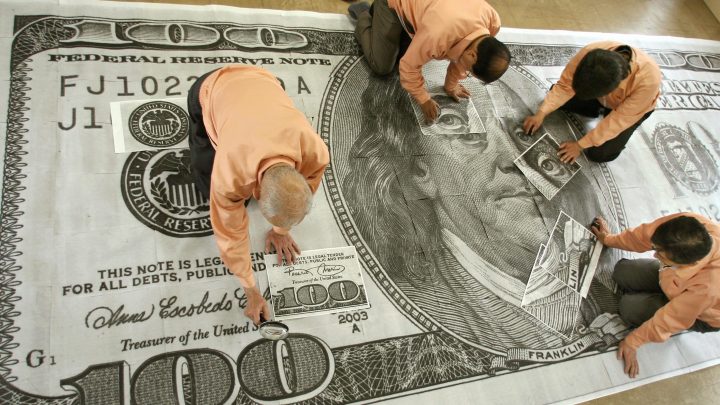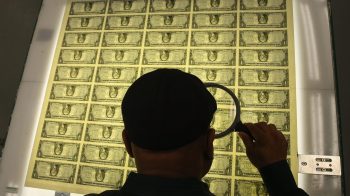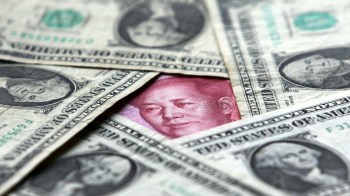
Five things to think about when Trump says he wants a weaker dollar
Five things to think about when Trump says he wants a weaker dollar

President Trump and his advisers have been talking a lot lately about the strength of the U.S. dollar, saying it’s weighing on U.S. exports and hurting American manufacturers. The President has criticized the Federal Reserve for not doing more to weaken the dollar; he even floated the possibility of taking action himself. As this story develops, here are some things to keep in mind.
1) The U.S. dollar is the most important currency in the world.
We normally think about the value of a dollar in terms of how much it can buy, but when you’re talking about the dollar big picture, it’s important to think about what it’s worth in the global economy.
Trillions of U.S. dollars are traded every single day. It’s used as an official and unofficial currency in a lot of other countries, it’s involved in around 90% of all foreign exchange transactions and it’s the benchmark currency for commodities like oil, copper and soybeans.
2) Whether the dollar is weak or strong depends on a complicated mix of global forces.
Dollar “strength” is relative. “The strength of the US dollar [depends on] a combination of a lot of forces,” said Menzie Chinn, professor of public affairs and economics and the University of Wisconsin, Madison. “Some governmental, both here and abroad, and lots of market forces.”
A dollar bill, which really is just a green piece of paper, has value because the government says it has value.
“Whether it keeps its value depends in large part upon whether the central bank is going to stand behind the currency, making sure that the currency doesn’t lose a lot of its value over time,” said Chinn.
Because the value of the dollar depends in large part on how much faith people have in what the Federal Reserve is going to do with interest rates, Chinn said, “people’s expectations about what the strength of the dollar will be in the future matter for today’s strength of the currency.”
The U.S. dollar’s strength is also affected by international forces such as what central banks in other countries are doing with their interest rates or whether they’re intervening in foreign exchange markets by buying and selling U.S. Treasuries.
3) The Trump administration has a tool they could use to weaken the U.S. dollar, but it doesn’t have a lot of firepower.
If the Trump administration decides that a currency intervention is necessary, they could use something called the Exchange Stabilization Fund, or ESF, to sell U.S. dollars and buy other currencies.
The ESF has around $100 billion in it. Megan Greene, an economist and senior fellow at Harvard’s Kennedy School, said only about half of that $100 billion is cash that could be deployed immediately.
“If you’re going to threaten to intervene to weaken the dollar, you need to be incredibly convincing,” said Greene. “If you only have $50 billion, that’s not particularly convincing, and so what will end up happening is, in open markets, investors are going to start betting on whether this will work or not.”
Investors betting against the success of the currency intervention will drive the dollar up, thus making the sums needed to drive the dollar down even bigger.
“Unfortunately, I think the U.S. is picking a massive fight with all of the bullies on the playground and is bringing a pea shooter to [the fight],” said Greene.
4) It’s unclear whether the Federal Reserve could help weaken the dollar if it wanted to.
“Traditionally, the Fed could help play a role in weakening the dollar,” Greene said. “But this time around might be different.”
The Federal Reserve has helped the U.S. government weaken the dollar before. They did it in 1985 as part of an international agreement called the Plaza Accord. “This time, the government would be going at it alone and also at a time when the president is constantly criticizing the Fed. So the Fed might be wary of going and doing the government’s bidding for it,” said Greene.
Even if the Fed did want to play a role in weakening the dollar, Greene said, “it’s really unclear whether that would work this time around.” Typically, when the Federal Reserve cuts interest rates, the dollar goes down. That didn’t happen this year.
“I think that’s because the U.S. dollar isn’t being driven by changes in monetary policy so much as fundamentals about U.S. growth,” said Greene. “If you look at the U.S. economy, it’s doing pretty well, particularly if you compare it to the rest of the developed world … and that’s pushing the dollar up.”
5) In times of uncertainty, the U.S. dollar tends to get stronger.
“The U.S. dollar is a special currency. It’s considered a safe asset,” said Menzie Chinn at the University of Wisconsin. “And so in times of discord, uncertainty or perceived risk, investors around the world and in the U.S. flock to dollar-based assets.”
Right now, the two biggest economies on the planet are in a trade war and nobody knows what’s going to happen.
“That uncertainty is driving lots of investors around the world towards safe assets and at the moment, that’s the dollar,” said Chinn.
“If Trump wanted to weaken the value of the dollar, one thing he could do is stop threatening other countries with additional tariffs and going back and forth, back and forth on what sort of threats he wants to impose upon other countries.”
There’s a lot happening in the world. Through it all, Marketplace is here for you.
You rely on Marketplace to break down the world’s events and tell you how it affects you in a fact-based, approachable way. We rely on your financial support to keep making that possible.
Your donation today powers the independent journalism that you rely on. For just $5/month, you can help sustain Marketplace so we can keep reporting on the things that matter to you.


















